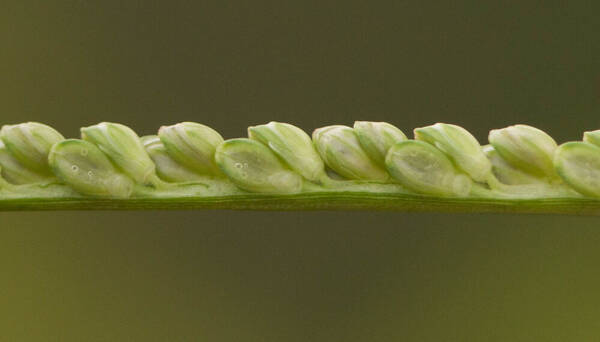Info
Subfamily: Panicoideae
Genus etymology: Paspalum = "millet" [Greek] some species are used as cereals
Species etymology: pilosum = "abundance of hairs" [Latin] refering to the hairy leaves
Photosynthetic type: C4 (warm season)
Nativity: naturalized - accidental
First recorded in Hawaiʻi: 2007
Map

Inflorescence




Plant


Habit

Spikelets









Landscape


Axillary inflorescence

Description
Habit: Perennial; caespitose. Culms geniculately ascending; 50-130 cm long; 1-3 mm diam. Culm-internodes thin-walled; distally glabrous to pilose. Culm-nodes glabrous, or bearded. Lateral branches sparse. Leaf-sheaths keeled; glabrous on surface, or pilose; with tubercle-based hairs; outer margin hairy. Leaf-sheath oral hairs ciliate; 3-6 mm long. Ligule an eciliate membrane; 0.6-2.5 mm long; brown. Collar glabrous, or bearded. Leaf-blades 10-25 cm long; 5-10 mm wide. Leaf-blade midrib conspicuous; keeled beneath. Leaf-blade surface pilose; hairy on both sides; with tubercle-based hairs. Leaf-blade margins ciliate. Inflorescences: Inflorescence composed of racemes; terminal and axillary. Peduncle glabrous, or pubescent above. Racemes 1; single; arcuate; unilateral; 6-12 cm long. Rhachis narrowly winged; folded longitudinally to embrace spikelets; 1-1.5 mm wide; ciliate on margins. Spikelet packing irregular. Spikelets in pairs. Fertile spikelets pedicelled; 2 in the cluster. Pedicels 1 mm long; pubescent. Spikelets: Spikelets comprising 1 basal sterile florets; 1 fertile florets; without rhachilla extension. Spikelets obovate; dorsally compressed; plano-convex; 2.6-3.2 mm long; falling entire. Fertile Spikelets: Spikelets comprising 1 basal sterile florets; 1 fertile florets; without rhachilla extension. Spikelets obovate; dorsally compressed; plano-convex; 2.6-3.2 mm long; falling entire. Glumes: Glumes two; shorter than spikelet; thinner than fertile lemma. Lower glume ovate, or oblate; 0.5-2 mm long; 1 -veined. Lower glume lateral veins absent. Upper glume ovate; 2.4-3 mm long; 0.8-0.9 length of spikelet; membranous; without keels; 5 -veined. Florets: Basal sterile florets male; with palea. Lemma of lower sterile floret similar to upper glume; elliptic; 1 length of spikelet; membranous; 4-5 -veined; without midvein, or with evident midvein. Fertile lemma ovate; 2.5-2.8 mm long; indurate; pallid; without keel. Lemma surface striate. Lemma margins involute. Palea involute; indurate. Flowers: Anthers 3; 1-1.2 mm long; purple. Fruits: Caryopsis with adherent pericarp. Distribution: North America: Mexico. South America: Mesoamericana, Caribbean, northern South America, western South America, and Brazil.
(Description source: Clayton, W.D., Vorontsova, M.S., Harman, K.T. and Williamson, H. (2006 onwards). GrassBase - The Online World Grass Flora. Available at https://powo.science.kew.org )